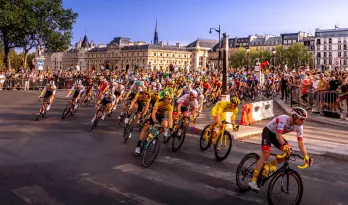Tour de France in Paris, route in 2022
After a long journey through France and some border countries, the Tour de France will finish its race in Paris on 24 July. Take advantage of your stay in the capital to discover the main monuments. Our Paris Discovery tour allows you to explore the city at your own pace.

What is the history of the Tour de France?
The Tour de France takes place every year during the summer over a period of three weeks. Géo Lefèvre, a sports journalist, was the initiator of the event. He put forward the idea of creating a Tour de France by bicycle in 1902.
In 1903, Henri Desgrange, a cycle racer and editor of the Parisian sports daily L'Auto, created the Tour de France, also known as the Grande Boucle. At first, the Tour was held for a surprising reason, namely to boost the image of the newspaper L'Auto.
Henri Desgrange was the organiser of the Tour until 1936. He imposed a strong discipline, which contributed greatly to making the event a legend. Originally, the riders were not allowed any form of external assistance on the road and had to repair their bikes themselves in case of a technical incident.
A monument to Henri Desgrange has been erected at the top of the Col du Galibier and a Henri-Desgrange prize is awarded each year during the Tour to the cyclist who crosses the summit first.
The beginnings of the Tour de France
The night stages were abolished in 1905. This year saw the appearance of the first stage on the hills: those of the Alsace balloon.
The Tour made its first foray into a border country in 1906 and crossed the Franco-German border.
The first passages in the mountain ranges took place in 1910 in the Pyrenees and in 1911 in the Alps.
For the first time, in 1926, the Tour started in the provinces, in Evian, Haute-Savoie.
In 1930, the famous publicity caravan was born. This line of unusual vehicles passes by about an hour before the cyclists and distribute all kinds of objects, much to the delight of the spectators.
Finally, the best climber prize and a half-stage individual time trial were created in 1933.
A media event
From the outset, the Tour de France was an event that was closely followed by the media, particularly the written press. In 1930, listeners were treated to the first live radio report by Jean Antoine and Alex Virot. Radio, which was then able to give live results, replaced the newspaper.
From the end of the 1940s, television took over. In order to ensure proper monitoring of the race, all sorts of means were used. The first live coverage of an Alpine summit was limited to a still shot of the pass. It was not until the 1960s that live television reports allowed the viewer to be at the heart of the race, thanks to cameras mounted on motorbikes and relayed by plane or helicopter.
What are the different jerseys?
Some accomplishment or positions in the races are rewarded by a yellow, green, white with red dots or white jersey.
The yellow jersey
An allegory of the Tour, the yellow jersey was created in 1919. This jersey rewards the best rider in the general classification, the one who has the best time in all stages combined. The jersey is yellow because the newspaper l'Auto was yellow. The yellow jersey has become the emblem of the Tour and remains the dream of many professional riders.
The green jersey
The green jersey was not always green. In 1968, it was replaced by a red jersey (as for the leader of the Vuelta, the Tour of Spain). A change that did not please, because the following year the jersey returned to its usual green colour.
This jersey rewards the best riders, by points, at the finish of each stage. It prioritises sprint finishes, with many more points awarded than at the finish of a mountain stage. Intermediate sprints have been added to the race with additional points awarded for several years.
The white jersey with red spots
Created in 1975, this jersey is awarded to the best climber in the Tour de France. It rewards riders who finish at the top of the mountain passes (or climbs listed in the classification), with the same points system as for the green jersey.
This classification appeared in 1933, at which time it was not yet represented by the white jersey with red spots. The number of points varies according to the difficulty of the pass. Thus, the "out of category" passes are harder than the 1st, 2nd, 3rd and 4th category passes.
The white jersey
This is awarded to the best rider under 25 years of age in the competition. This classification is based on the general classification. Created in 1975 (at the same time as the polka dot jersey), it disappeared between 1989 and 1999, then reappeared in 2000.
Route of the 2022 Tour de France
The 2022 Tour de France runs from Friday 1 to Sunday 24 July 2022. For its 109th edition, it will include 21 stages for a total distance of approximately 3228 kilometres. The route includes 6 flat stages, 6 mountain stages, 7 hilly stages and 2 individual time trial stages.
The 21st and final stage of the Tour de France 2022 awaits you on Sunday 24 July 2022 on the Avenue des Champs-Élysées for the final sprint.
To continue your discovery of Paris, discover our selection of ideas for visiting the capital this summer: museums, parks and gardens, events and historical sites.